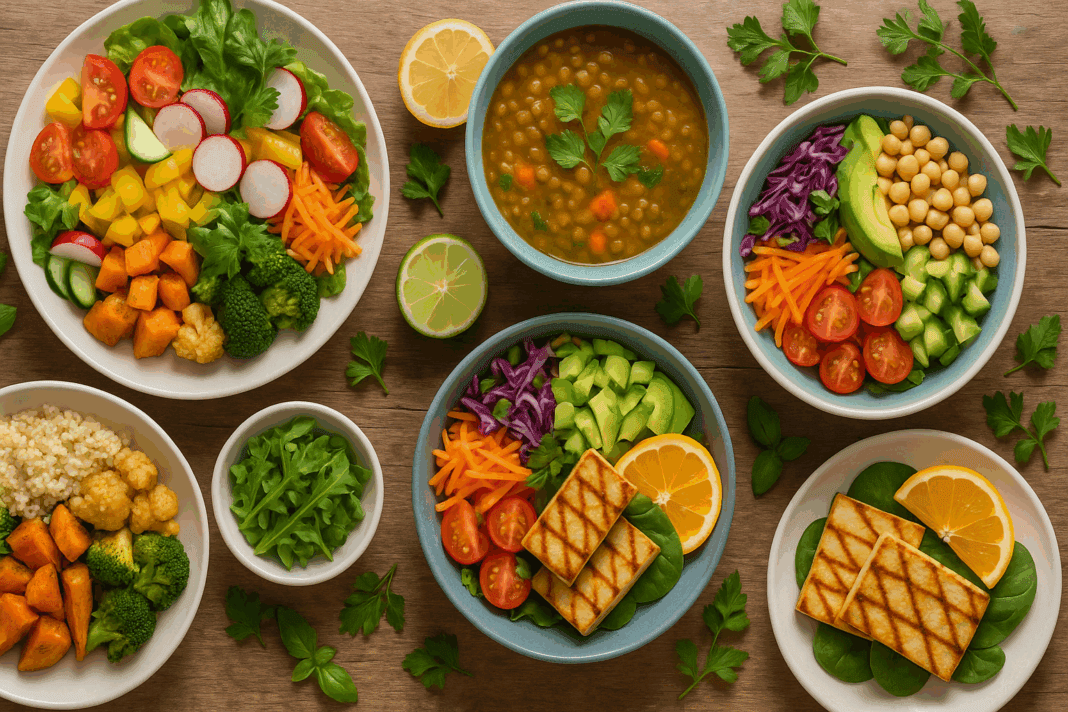Why Light Meals Matter for Health, Energy, and Long-Term Wellness
Modern eating patterns have evolved rapidly, but many people are returning to the fundamentals—focusing less on extreme diets and more on how meals actually make them feel. For those who want to enjoy food while promoting wellness, light meals offer a thoughtful approach to nourishment without excess. Rather than relying on calorie-dense ingredients that weigh the body down, light meals favor balance, freshness, and digestibility.
Unlike crash diets or deprivation strategies, light eating emphasizes whole foods, mindful preparation, and nutritional density. This means meals that are rich in fiber, antioxidants, and healthy fats, while also being low in refined sugars and saturated fats. The beauty of this approach is its sustainability—light meals can be enjoyed daily without sacrificing flavor, cultural diversity, or fullness.
The benefits of eating lighter meals extend beyond weight management. Many individuals experience increased mental clarity, better digestion, more restful sleep, and improved mood when they transition to light foods to eat throughout the day. These benefits are particularly valuable for people managing chronic health issues such as diabetes, hypertension, or high cholesterol. But even for those in excellent health, the choice to eat light meals supports longevity and enhances quality of life.
Ultimately, light eating is not about eating less—it’s about eating smarter. It invites you to slow down, savor your food, and consider not just what’s on your plate but how it serves your health and lifestyle. As we’ll explore in this article, light meal ideas can be exciting, diverse, and deeply satisfying.
You may also like: Smart, Simple Recipes for a Balanced Diet: Expert-Backed Healthy Food Dishes to Support Everyday Wellness
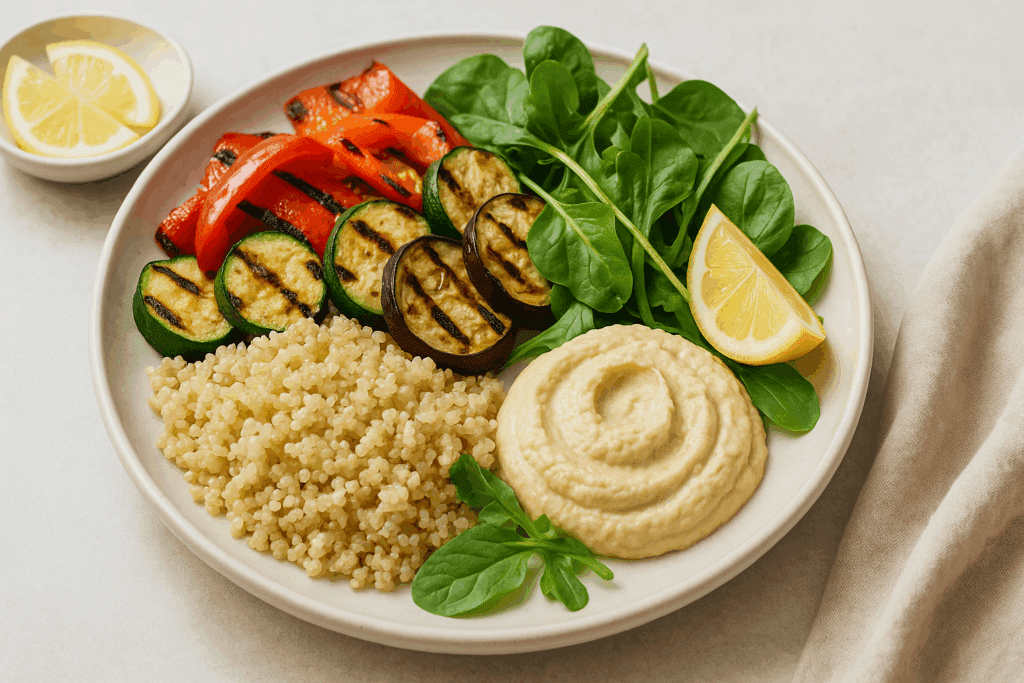
What Makes a Meal ‘Light’ Yet Still Satisfying?
It’s easy to assume that light meals are synonymous with small portions or bland ingredients, but this couldn’t be further from the truth. A well-designed light meal should feel complete and flavorful while delivering nourishment without heaviness. So, what makes a meal light in the first place?
From a nutritional standpoint, light meals are typically lower in calories and unhealthy fats but rich in essential nutrients. This often involves building meals around light foods like leafy greens, legumes, seasonal vegetables, whole grains, and plant-based proteins. These components provide a sense of satiety due to their fiber content and nutrient density, without the bloating or sluggishness that comes with heavier, highly processed fare.
Cooking methods also play a significant role. Light meals usually rely on techniques like steaming, grilling, roasting, or sautéing with minimal oil. These approaches preserve the natural taste of foods while enhancing texture and aroma. A light supper, for example, may consist of a grilled vegetable salad with quinoa, lightly dressed in olive oil and lemon—a meal that’s easy on the stomach yet full of depth.
Moreover, the time of day matters. Heavy meals late in the evening can interfere with digestion and sleep, whereas light dinners support restful sleep and hormonal regulation. Choosing light meal recipes that emphasize balance, such as a bowl of miso soup with tofu and greens, helps the body prepare for recovery during the night.
Satisfaction, then, is not just physical—it’s emotional and psychological. Light meals should leave you feeling energized and nourished, not deprived. When crafted thoughtfully, light foods to eat can fulfill both your hunger and your cravings.

Health Benefits of Choosing Light Foods for Everyday Eating
The transition to lighter eating isn’t just a trend—it’s a science-backed choice that supports overall well-being. Research in nutrition and metabolic health shows that diets rich in whole, light foods are associated with lower risks of obesity, heart disease, type 2 diabetes, and even certain cancers. But how do light meals contribute to these outcomes?
One of the most significant benefits of light meals is their impact on blood sugar regulation. When meals are built around fiber-rich vegetables, legumes, and whole grains, they help slow the absorption of glucose and prevent insulin spikes. This is crucial for people managing prediabetes or metabolic syndrome. Light dinners that focus on lentils, leafy greens, and moderate amounts of whole grains are a perfect example of meals that stabilize energy levels without triggering inflammation.
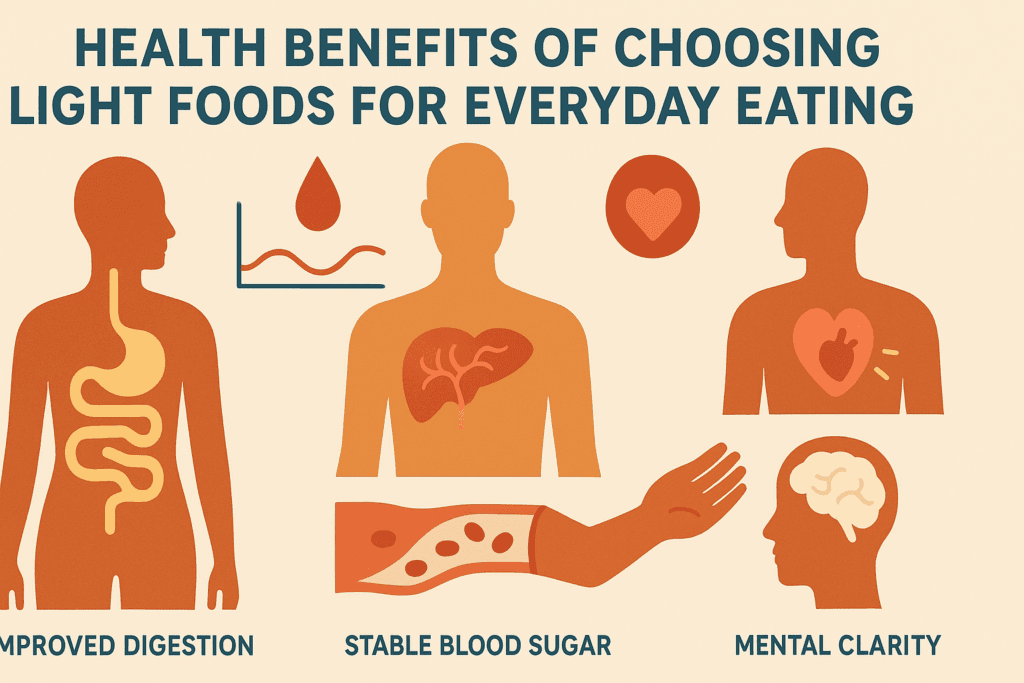
Heart health is another area where light foods excel. Many light meal ideas center around foods high in unsaturated fats and antioxidants—such as nuts, seeds, olive oil, and berries—which have been shown to reduce bad cholesterol and improve arterial function. A simple light supper like roasted vegetables with tahini dressing or a chickpea salad with olive oil and lemon not only tastes great but actively supports cardiovascular health.
Digestion also benefits from lighter eating. Heavy, greasy meals can slow down gastrointestinal function and cause discomfort. In contrast, light meals, especially when spaced evenly throughout the day, keep the digestive system active without overloading it. This promotes better nutrient absorption, less bloating, and more consistent bowel movements.
By choosing light foods to eat regularly, you’re also giving your body a metabolic advantage. Lighter meals reduce the burden on internal organs, enhance detoxification pathways, and support hormonal balance. Over time, this can translate into better energy, clearer skin, improved mood, and a healthier weight without rigid dieting.
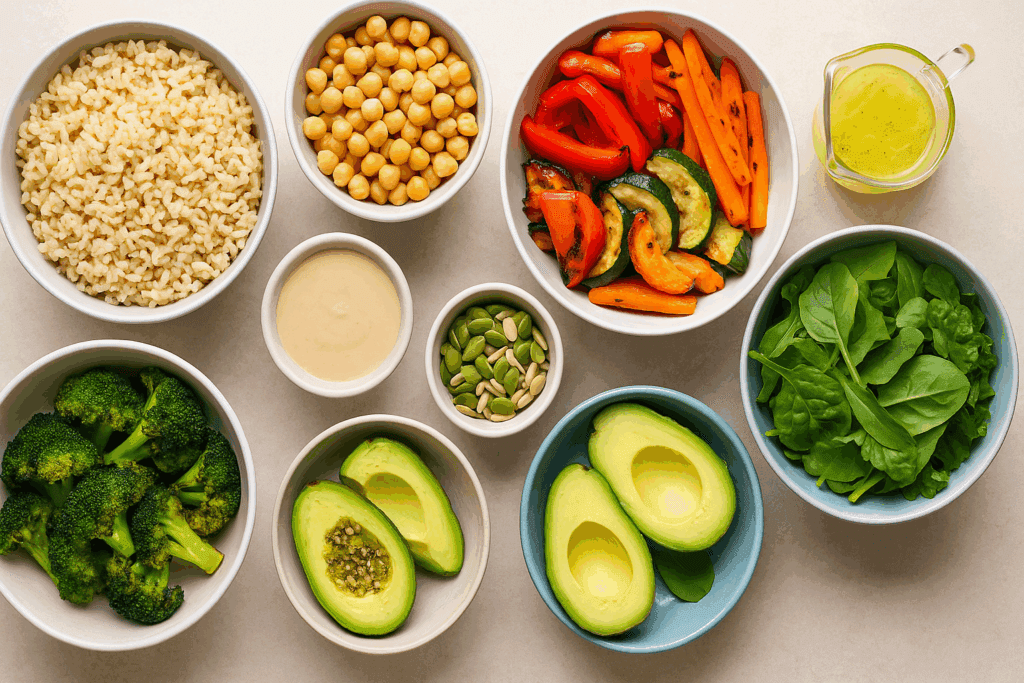
How to Create Light Meals That Are Both Nourishing and Delicious
Designing a light meal doesn’t require culinary expertise, but it does benefit from a few guiding principles. The most effective light meal ideas include a variety of whole-food ingredients that provide balance, texture, and flavor. Start with a foundation of vegetables—preferably a mix of raw and cooked options to maximize both nutrient availability and digestibility.
The next layer should include a plant-based protein source. This might be lentils, tofu, tempeh, or even edamame. These ingredients help keep you full and maintain muscle mass, especially important for active individuals or older adults. When combined with vegetables and healthy fats, they make for deeply satisfying light meals that don’t leave you hungry an hour later.
Complex carbohydrates are also key, but they must be chosen wisely. Whole grains like brown rice, farro, and barley digest slowly and pair beautifully with plant-based dishes. For example, a grain bowl topped with grilled zucchini, roasted chickpeas, avocado slices, and a tahini-lime sauce is not only satisfying but also falls perfectly within the realm of light meal recipes.
Don’t overlook the importance of seasonings. Herbs, citrus, vinegars, and spices can transform simple ingredients into memorable dishes. The goal with light cuisine recipes is to create meals that feel vibrant, clean, and refreshing. Whether you’re making a Thai-inspired vegetable curry with light coconut milk or a Mediterranean chickpea salad with cucumber and mint, flavor should never be sacrificed.
Finally, consider meal timing. Eating a light supper in the evening rather than a heavy meat-and-potatoes dish gives your digestive system time to rest and reset. This supports better sleep and hormonal repair overnight—essential elements of a healthy lifestyle.
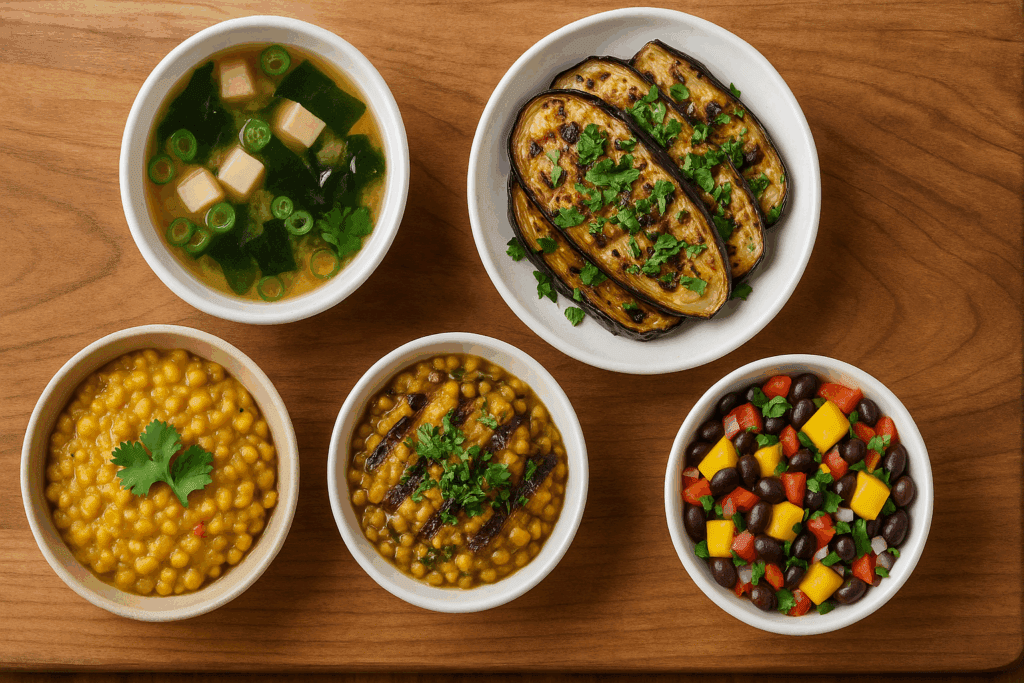
Global Inspirations for Light Cuisine Recipes That Satisfy and Nourish
Cultures around the world have long embraced the principles of light eating. Traditional diets from Asia, the Mediterranean, and Latin America often prioritize whole plant foods, minimal processing, and a balance of macronutrients. Drawing from these traditions can inspire endless light meal ideas that go beyond the typical salad.
Japanese cuisine, for instance, offers meals that are naturally light and balanced. Miso soup, pickled vegetables, tofu, steamed rice, and small portions of fish create meals that are high in umami, low in fat, and deeply satisfying. These dishes are not only easy to digest but are often linked to the longevity of the Japanese population.
Mediterranean meals are another excellent source of inspiration. Think grilled eggplant with garlic and lemon, lentil salads with fresh herbs, or tomato-based vegetable stews with olive oil. These light cuisine recipes prioritize heart-healthy fats, fiber, and vibrant flavor combinations, making them ideal for daily meals that support overall well-being.
From India, we can take cues from traditional vegetarian thalis—balanced plates that include dal (lentils), sautéed greens, pickled vegetables, and whole grains like brown rice or millet. These components come together in perfect harmony, offering nourishment and variety without excess.
In Latin American kitchens, light foods often take the form of plantain dishes, bean salads, and tropical fruit-based salsas. When paired with a small portion of avocado or a corn tortilla, these ingredients create light dinners that are culturally rich and nutritionally sound.
By weaving together global flavors and preparation styles, you can continually rotate new, satisfying, and health-promoting light meals into your routine without boredom or burnout.

Making Light Meals Work in Real Life: Practical Strategies for Busy People
For many, the biggest challenge with light meals isn’t understanding the benefits—it’s finding time to prepare them consistently. Fortunately, with a little planning and a few simple strategies, eating lighter can fit easily into any lifestyle.
Batch cooking is a powerful tool. Spend a few hours once a week roasting vegetables, preparing grain bases, cooking legumes, and assembling sauces. This way, you’ll have the foundation for multiple light meal recipes ready to go. Just mix and match ingredients to keep things fresh.
Stocking your pantry with versatile, healthful staples also helps. Canned beans, quinoa, brown rice, frozen vegetables, and healthy oils allow you to pull together balanced meals even when time is tight. With these on hand, a quick light supper can come together in under 15 minutes.
Another effective strategy is meal layering. For example, a basic green salad can become a full meal by adding warm lentils, a scoop of farro, roasted sweet potatoes, and a dollop of hummus. This makes light meals more exciting, filling, and versatile.
If you’re eating out or ordering in, scan the menu for dishes built on vegetables and legumes, and ask for dressings or sauces on the side. Many restaurants now offer health-conscious options, making it easier than ever to enjoy light foods to eat even on the go.
What matters most is consistency. Light eating doesn’t have to be perfect—it just needs to be intentional. When you approach meals with curiosity, creativity, and a focus on how food makes you feel, light meals become a joyful, integral part of your daily life.
Frequently Asked Questions: Light Meals and a Healthier Lifestyle
1. How can light meals support mental clarity and cognitive performance throughout the day?
Light meals are known not only for their digestive benefits but also for their ability to enhance mental focus. Heavy meals rich in saturated fats and simple carbohydrates can cause brain fog and sluggishness due to post-meal blood sugar fluctuations and digestive fatigue. In contrast, light foods that are high in antioxidants, omega-3s, and fiber—like leafy greens, flaxseeds, and legumes—promote better blood flow to the brain and steady glucose levels. Choosing light foods to eat during the workday, such as a vegetable stir-fry with quinoa or a hearty lentil salad, can help maintain alertness without the crash. Many nutritionists recommend structuring your lunch around well-balanced light meal ideas to support cognitive performance into the afternoon.
2. What are some creative ways to repurpose leftover light dinners for the next day’s lunch?
Repurposing light dinners into next-day lunches is an efficient way to reduce waste and maintain variety. A grilled vegetable plate from a light supper can be transformed into a wrap with hummus and greens, while a serving of brown rice and tofu can become the base of a burrito bowl with added salsa and avocado. Soups and stews—common light meal recipes—often taste better the next day and can be paired with a slice of whole-grain toast for added texture. Roasted sweet potatoes, chickpeas, and tahini dressing from last night’s dinner make a perfect cold salad lunch the next day. Planning your light meals with versatility in mind allows you to streamline meal prep without sacrificing taste or nutrition.
3. How do light cuisine recipes impact hormonal balance, especially for women?
Many light cuisine recipes contain plant-based compounds that support hormonal equilibrium, particularly in women. Cruciferous vegetables like broccoli and kale, often found in light meal recipes, contain indole-3-carbinol—a compound that aids estrogen metabolism. Additionally, the inclusion of healthy fats such as avocado and seeds helps maintain hormone production, while high-fiber components assist in estrogen excretion. Because light meals avoid the hormone-disrupting additives found in ultra-processed foods, they contribute to more stable menstrual cycles and improved mood regulation. Incorporating light foods into daily routines has become a central strategy in functional medicine protocols for hormonal health.
4. Are there any seasonal advantages to eating more light foods during warmer months?
Yes, shifting toward light meals during warmer seasons aligns with both traditional eating patterns and modern physiological needs. In hot weather, digestion naturally slows, and lighter foods like salads, smoothies, and grilled vegetables become more appealing and easier on the stomach. Many light foods to eat—such as cucumbers, watermelon, and leafy greens—also have high water content, helping with hydration and electrolyte balance. Light meal ideas for summer may include chilled soups, zoodle bowls with fresh tomato sauce, or poke-style grain bowls. These meals not only reduce the risk of overheating but also provide a refreshing alternative to the heavier fare typically consumed in colder months.
5. How can light meal recipes be adapted for athletes or individuals with higher caloric needs?
Light meals can absolutely be tailored to fuel athletic performance without compromising their core principles. The key is to increase the portion size of nutrient-dense ingredients rather than relying on calorie-dense processed foods. For example, a light cuisine recipe that includes quinoa, roasted chickpeas, and sautéed greens can be enhanced with additional olive oil, seeds, or avocado to raise its caloric profile. Athletes may also benefit from adding fermented foods like kimchi or tempeh to their light meals for gut health, which supports nutrient absorption and recovery. For those training intensely, incorporating more frequent meals built around light foods to eat helps sustain energy while promoting lean muscle mass and efficient digestion.
6. What are the psychological benefits of incorporating light meals into a daily routine?
Beyond physical health, light meals can play a powerful role in improving psychological well-being. The act of preparing and enjoying light foods promotes mindfulness, encouraging a slower, more intentional relationship with food. Regular consumption of light dinners can reduce the risk of nighttime overeating, which is often tied to emotional stress or fatigue. Over time, many people report feeling more in control of their eating habits and experiencing fewer mood swings when shifting to light meal ideas. Additionally, the consistent inclusion of nutrient-dense ingredients—especially those high in magnesium and B-vitamins—supports neurotransmitter production, contributing to improved emotional balance.
7. How can families with children introduce more light foods without resistance?
Involving children in the preparation of meals is one of the most effective ways to make light foods more appealing. Let kids assemble their own bowls or wraps using colorful ingredients, such as shredded carrots, chickpeas, cherry tomatoes, and hummus. Making light meal recipes fun—like creating veggie sushi rolls or rainbow salads—can foster curiosity and positive associations with healthy eating. Families can also incorporate light cuisine recipes inspired by familiar favorites, such as zucchini noodles with marinara or homemade vegetable tacos, to reduce resistance. Gradually introducing light meals during lunch or dinner routines allows children to explore these foods at their own pace and form lifelong healthy habits.
8. Can light supper options be beneficial for people experiencing digestive disorders?
Yes, a well-chosen light supper can be especially helpful for individuals managing IBS, GERD, or other digestive sensitivities. Eating smaller, lighter meals in the evening reduces the likelihood of acid reflux and bloating, particularly when meals avoid common irritants like excessive fat, spice, or acidic components. Light meal recipes that feature steamed vegetables, lentils, and gluten-free grains like rice or millet are easier to digest and gentler on the gastrointestinal tract. Herbal additions such as fennel or ginger can further soothe digestion when included in light dinners. The consistency of choosing light foods to eat at night may help reduce the frequency and severity of digestive flare-ups over time.
9. How is the rise of plant-based eating influencing modern light cuisine recipes?
The global shift toward plant-based diets has deeply enriched the world of light cuisine. Chefs and home cooks alike are exploring innovative light meal recipes using tempeh, jackfruit, aquafaba, and legumes as main components. These plant-forward meals align perfectly with the principles of light eating—low in saturated fats, high in fiber, and rich in phytochemicals. Vegan sushi bowls, Mediterranean mezze plates, and Thai-inspired tofu stir-fries are all contemporary light meal ideas emerging from this trend. As demand for health-conscious, eco-friendly food grows, plant-based light dinners are becoming more mainstream and accessible, even at restaurants and in meal delivery services.
10. What role do light meals play in sustainable eating and environmental health?
Eating light meals contributes significantly to environmental sustainability by reducing reliance on resource-intensive animal products and minimizing food waste. Many light foods, such as lentils, grains, and vegetables, have a lower carbon footprint compared to meat and dairy. Additionally, light cuisine recipes often use seasonal and local produce, reducing transportation emissions and supporting regional farmers. By choosing light foods to eat that are plant-based and minimally packaged, consumers can reduce their environmental impact while improving their own health. In this way, adopting light meal ideas becomes not just a personal wellness choice, but also a meaningful act of environmental responsibility.
Conclusion: Light Meals as a Foundation for Lifelong Health and Joyful Eating
In the journey toward better health, light meals provide a path that is as pleasurable as it is practical. They are rooted in tradition, backed by science, and aligned with the body’s natural rhythms. When you consistently choose light foods to eat, you support digestion, enhance energy, and build resilience from the inside out.
Whether you’re exploring new light meal ideas, looking for globally inspired light cuisine recipes, or simply seeking more satisfying light dinners that won’t leave you sluggish, the key is to approach food with mindfulness and purpose. Light eating isn’t about denial—it’s about choosing ingredients and meals that uplift you.
As we’ve seen, incorporating more light meals into your routine can transform your physical well-being, mental clarity, and emotional connection to food. With just a bit of planning and a spirit of exploration, these meals can become a cornerstone of your healthier lifestyle, one delicious bite at a time.
Was this article helpful? Don’t let it stop with you. Share it right now with someone who needs to see it—whether it’s a friend, a colleague, or your whole network. And if staying ahead on this topic matters to you, subscribe to this publication for the most up-to-date information. You’ll get the latest insights delivered straight to you—no searching, no missing out.
healthy eating habits, plant-based dinners, nutritious meal planning, digestive wellness meals, anti-inflammatory recipes, light vegetarian meals, healthy food preparation tips, balanced diet ideas, clean eating meals, portion control strategies, easy healthy dinners, mindful eating practices, heart-healthy recipes, low-calorie dinner inspiration, fresh seasonal meals, whole-food nutrition, vegetarian lifestyle meals, gut-friendly recipes, energizing plant-based foods, healthy meal prepping
Further Reading:
10 Simple Dinner Ideas for Healthy Eating in Real Life
53 Dinner Recipes for Weight Loss
20 Heart-Healthy Vegetarian Dinners You’ll Want to Make Forever
Disclaimer
The information contained in this article is provided for general informational purposes only and is not intended to serve as medical, legal, or professional advice. While NewsHealthWatch strives to present accurate, up-to-date, and reliable content, no warranty or guarantee, expressed or implied, is made regarding the completeness, accuracy, or adequacy of the information provided. Readers are strongly advised to seek the guidance of a qualified healthcare provider or other relevant professionals before acting on any information contained in this article. NewsHealthWatch, its authors, editors, and contributors expressly disclaim any liability for any damages, losses, or consequences arising directly or indirectly from the use, interpretation, or reliance on any information presented herein. The views and opinions expressed in this article are those of the author(s) and do not necessarily reflect the official policies or positions of NewsHealthWatch.

